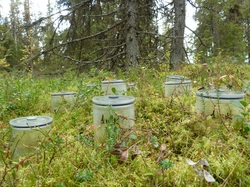Hi! This is Maria writing after this autumn's fieldtrip in North Sweden. The last time I was that far up in the north was in 2007 when I was doing some research studies in Abisko as part of Gareth Phoenix´s group. At that time I was impressed with the landscape, now I am convinced Scandinavia is an amazing place to do fieldwork, Tom thank you very much for offering me this job!

I stayed in Arjeplog over a month living in a yellow Swedish wooden house and working in close collaboration with colleagues from Silvermuseet, with whom I had the opportunity to share expertise and collate scientific knowledge for a better understanding of the boreal forest. Tom arrived the second week and together we set up a new experiment that will help us to describe the fate of the newly fixed nitrogen. We are really excited about the results we are going to get. Setting up was indeed exciting not just due to the questions we are trying to answer but also because it involved collaboration with people from Arjeplog who offered their assistance. We are indebted for their help without which it would have been very difficult to run a 240V AC peristaltic pump for 24 h continuous sampling during 21 days in a remote area in the middle of the boreal forest! that was amazing, thanks!
I read in a very interesting book about bryophytes that the predominance of Pleurozium schreberi in the boreal forest does not result from its better adaptive potential to ecological conditions, but rather from its ability to remove others, like Ptilidium, Ptilium or Dicranum, through competitive interaction by means of a growth strategy orientated towards the fast occupancy of space. If you are a cyanobacteria, this is excellent news since an increasingly large body of literature is pointing towards the high degree of host specificity of these microorganisms, and guess what, they love Pleurozium schreberi as a substrate for growing! Why? We are still trying to find out. If you are a tree growing in the boreal forest where nitrogen is very limited, this is also very good news. First because these associations represent an important source of new nitrogen to the ecosystem through the process of nitrogen fixation. However we still need to describe how the newly fixed nitrogen is transfered from the moss system to the tree. The results from this fieldtrip will provide the scientific community with new results to try to solve this puzzle. Secondly, it is also recognized that nutrients can be leached from Pleurozium schreberi after disturbance events -for example after membrane damage from desiccation following wet / dry cycles- which may serve as source of nutrients. However our understanding of this process is limited regarding the net impact. This autumn we have run different studies to try to help fill this knowledge gap.
Another interesting discovery of this autumn's fieldtrip was the Sami singer Sofia Jannok and her album Áphi / Wide as Oceans: very much recommended, thanks Ingela!
I read in a very interesting book about bryophytes that the predominance of Pleurozium schreberi in the boreal forest does not result from its better adaptive potential to ecological conditions, but rather from its ability to remove others, like Ptilidium, Ptilium or Dicranum, through competitive interaction by means of a growth strategy orientated towards the fast occupancy of space. If you are a cyanobacteria, this is excellent news since an increasingly large body of literature is pointing towards the high degree of host specificity of these microorganisms, and guess what, they love Pleurozium schreberi as a substrate for growing! Why? We are still trying to find out. If you are a tree growing in the boreal forest where nitrogen is very limited, this is also very good news. First because these associations represent an important source of new nitrogen to the ecosystem through the process of nitrogen fixation. However we still need to describe how the newly fixed nitrogen is transfered from the moss system to the tree. The results from this fieldtrip will provide the scientific community with new results to try to solve this puzzle. Secondly, it is also recognized that nutrients can be leached from Pleurozium schreberi after disturbance events -for example after membrane damage from desiccation following wet / dry cycles- which may serve as source of nutrients. However our understanding of this process is limited regarding the net impact. This autumn we have run different studies to try to help fill this knowledge gap.
Another interesting discovery of this autumn's fieldtrip was the Sami singer Sofia Jannok and her album Áphi / Wide as Oceans: very much recommended, thanks Ingela!
 RSS Feed
RSS Feed